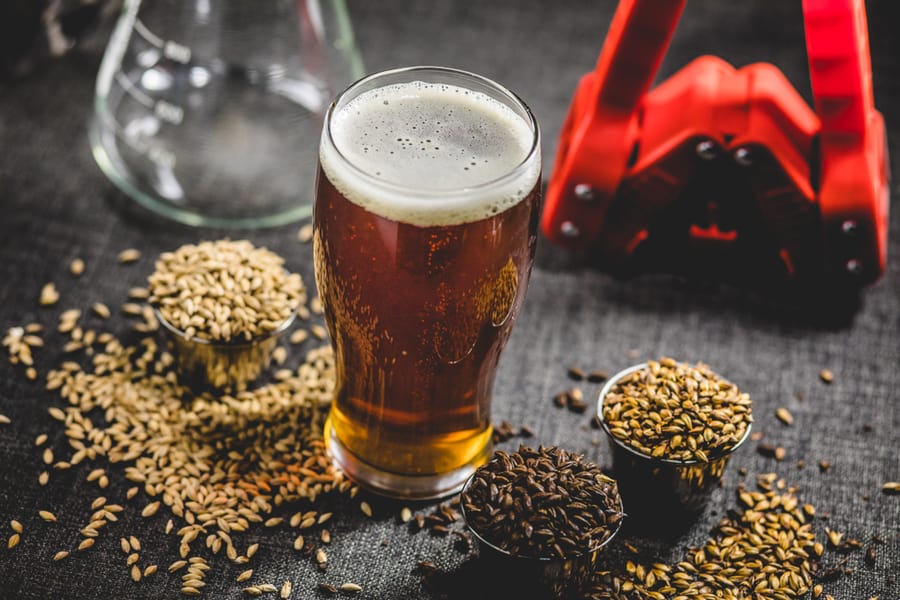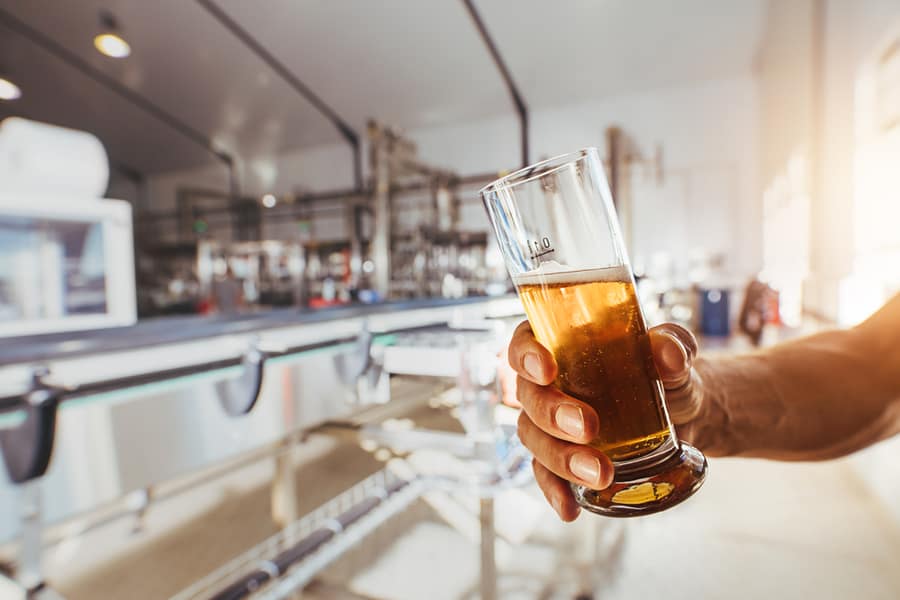
Brewing is an ancient process with roots stretching back over 12,000 years. People liked to imbibe even then. It is said that brewing is a flirtatious dance between science and art.
There’s the measurement and sanitary aspect, and on the other hand, there’s the artisanal aspect where a brewer makes creative decisions. Simply put, brewing is boiling grains, letting them cool, fermenting them, and finally enjoying the brew.
So, let’s investigate what brewing is.
Brewing is a blend of art and science, involving the selection of grains like barley, hops, water, and yeast strains. The grains are milled to expose starches, which become sugars during fermentation. Warm water is added to release sugars, creating a mixture called wort. Yeast is then added to convert sugar into carbon dioxide and alcohol through fermentation. After maturation, the beer is bottled and ready to be enjoyed.
We’ll investigate the beer brewing process from the perspective of home and commercial brewers because both follow the same principles. Home brewing gives you an idea of the amount of work in a commercial brewery. In contrast, commercial brewing can almost be replicated in your kitchen. So let’s crack a cold one open and see what’s brewing!
The Brewing Process

Let’s look deeper at the flirtatious dance between science and art, shall we? We can break down the brewing process into several yet interrelated steps.
Our focus will be a mixture of commercial and home brewing because both follow the same basic steps.
Gathering the Supplies
This is part of science and art. You need the right equipment and ingredients to brew beer, right? So, let’s take a look.
The home brewer among us knows that sanitizing your equipment is non-negotiable. You must work with clean equipment; otherwise, you might introduce unwanted bacteria to your brew, which may lead to a bad batch of beer.
Sanitizing anything you’re going to use during the brewing process is crucial. For first-time home brewers, we’d recommend purchasing a home brewing kit.
Grain Milling
To end up with beer, you need sugar to feed the yeast to start fermentation. The sugar comes from sprouted barley (malted barley) which is milled or crushed to expose the starchy inner core of the barley grains.
Commercial brewers will buy their grains from a supplier and handle the milling process in-house to achieve the desired coarseness. Homebrewers usually purchase their grains from a craft beer supplier.
Creating the Mash and Mashing
Saccharification is the technical word when the ground malt is mixed with warm water to convert the starch into fermentable sugars.
It should go without saying that the best water for brewing is the cleanest possible water, and that rules tap water out because of the chemical processes used to treat the water. Therefore, spring water or reverse-osmosis-treated water is the best choice any home brewer can make to ensure a sensational brew.
The saccharification process is carefully controlled to ensure that all the sugars are extracted. British ales are usually made in a one-step mashing process: the mash is raised and kept at 65ºC (140ºF) for an hour.
During this time, maltose (a type of sugar) is released from the grain through enzyme actions within the grain. This process is called an infusion mash.
To ensure the complete extraction of all the sugars, brewers perform a step mash where the temperature is raised at different intervals to break down the other parts of the malted barley grain’s starchy core (the endosperm).
- At 95°F–113°F (35°C–45°C), proteases occur—the protein matrix holding the starch granule breaks down.
- Between 113°F–131°F (45°C–55°C), the hemicellulose gums are broken down through glucanase enzymes.
- Finally, amylase occurs between 141.8°F–152.6°F (61°C–67°C) when the starch granules and larger sugar molecules break down into fermentable sugars.
This process needs to be stopped by ‘mashing out.’ First, the mash’s temperature is raised to around 170ºF (77ºF) to eliminate all enzymatic activity.
Lautering and Sparging the Mash
Lautering refers to the process where the boiled mash is rinsed or washed. The liquid that’s washed off the spent mash and the liquid that’s already there is called the wort.
The wort is full of the sugars and other flavor compounds released from the grains during the heating process of the previous step. Home brewers will save this liquid in a sterile container because this is the liquid step in the brewing process.
Commercial brewers have the space and equipment to sparge their mash or sprinkle hot water over the grain to rinse the sugar off when the wort is drained from the lauter tun. Usually, commercial brewers can follow one of three methods to achieve sparging:
- No-sparge brewing avoids rinsing the wort and is placed in the boiling kettle with water. However, this method requires extensive equipment and isn’t as effective as the following two methods.
- Continuous-sparging or fly-sparing is the traditional German method where hot water is sprinkled over the grains. At the same time, the wort is drained at the bottom of the mash tun. Fly-sparging is the most efficient method but requires careful monitoring to avoid watering the wort down too much.
- The British prefer getting multiple beers (known as party-gyling) from the same mash through batch-sparging. Two or three individual runnings, or rinses, are combined into a single wort at the end.
Sparging is part of the lautering process and not a separate process. Homebrewers also need to sparge their wort to get the remaining sugar from their mash; otherwise, they discard the sugars the yeast will need when they ferment their beer.
You can read more about lautering for homebrewers here.
Boiling the Wort
After the wort is extracted, it requires boiling for several reasons:
- First, boiling stops the enzyme activity entirely, allowing the brewer to have completely inactive enzymes.
- It sterilizes the wort and kills any unwanted microorganisms, such as bacteria which may start feeding on the sugars in the liquid and spoil your up-and-coming batch of beer.
- Hops are added to the boiling wort to allow it to release its bittering agents, also known as alpha acids. Hops bring balance to the beer and act as a natural preservative protecting your beer from potential infections, unwanted bacteria, and other microbes. The addition of hops also helps to create a favorable environment for the fermentation to take place.
- Through boiling, volatile compounds evaporate from the wort—germinating barley releases a compound known as s-methyl-methionine (SMM) which will turn into dimethyl sulfide (DMS), giving your beer a corn-like aroma and flavor. Blergh!
- The proteins in the wort break down (like frying an egg in a pan when the white becomes solid) and bind with tannins forming clumps. As the wort boils, these protein-and-tannin clumps become larger and sink to the bottom of the boiling vessel.
Fascinating Fermentation
This is where beer starts to become real beer, and it’s all down to an army of microorganisms feeding on the sugars in the wort. The boiled wort needs to cool down before yeast is added to the mixture because adding yeast to the boiled liquid will kill all beneficial microorganisms.
Brewers refer to the process of adding yeast to the wort as pitching the yeast. Unfortunately, there’s nothing special about the process. The yeast is added to the wort, given a good stir, and left alone to do its job.
But before brewers can add yeast to the wort, it needs to be cooled down rapidly to room temperature—in less than 20 minutes. Usually, homebrewers will use an ice bath to cool the mixture down or a wort cooler to achieve the same process.
Fermentation can be divided into three stages:
- First: Initially, it would appear that the yeast is not doing anything during the lag phase. However, the yeast is active on a microscopic level and adapting to its new environment and food source. This phase lasts between 12 and 48 hours. It can be influenced by the ambient temperature, the humidity, or even the strain of yeast used to ferment the beer.
- Second: Active fermentation, or the growth phase, is when the yeast starts to feast on the sugars in the wort and convert them to alcohol and carbon dioxide (CO2). A promising sign for homebrewers is the Kräusen, or the brown-speckled, fluffy white foam floating on top of the wort converted to beer. Home fermentation can last anything from two days to two weeks, and there’s nothing you can do except wait for the yeast to enjoy itself and do its job. Commercial breweries usually ferment their beer between seven and ten days, sometimes even longer, depending on the style of beer they are producing.
- Final: The final phase, known as the stationary phase, is at the end of fermentation. The yeast has consumed almost all the sugar and starts to clump together or flocculate. The dead yeast clumps drop to the bottom of the fermenting vessel. This is the sign all brewers are waiting for—their beer is almost done.
Up to this point, the beer-brewing process and whisky production overlap but also go their separate ways. Whiskey is distilled from the fermented wort-and-water mixture, whereas beer is left alone to mature and clear.
Maturing and Clearing
During the maturation stage, the bear is allowed to rest, and the flavors improve. Some brewers refer to ‘secondary fermentation,’ although there’s not much fermentation happening. Another term is ‘racking to secondary,’ which still means the beer is allowed to rest.
Brewers may add other ingredients during this phase to arrive at the desired final flavor. During this rest period, the bear is allowed to stabilize.
After the maturation and clearing phase, the beer is bottled or transferred to a keg.
Conclusion
Brewing is the process of preparing grains for fermentation and fermenting the grains (or fruits for a fruit beer) that finally results in beer.
The brewing process we’ve outlined throughout this article is fundamental but should give you a good idea of how the brewing process works. Home brewers can look at this helpful infographic to understand the brewing process.
In this video, you’ll see an overview of the commercial function. So next time you crack open a cold one, spare a thought for the process and how your beer reached you.









